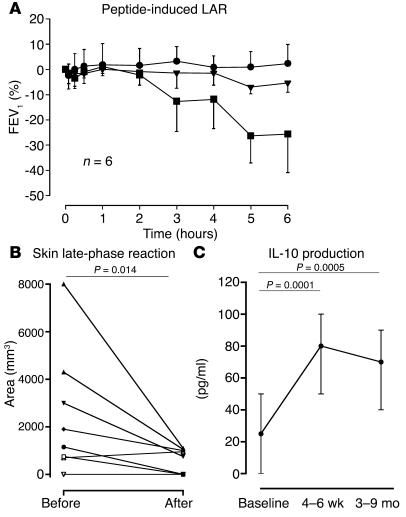Figure 4.
Peptide immunotherapy is associated with allergen-specific hyporesponsiveness and the induction of IL-10. (A) Cat-allergic asthmatic subjects (n = 6) were challenged intradermally with a mixture of 12 peptides (5 μg each) from the sequence of Fel d 1 or vehicle alone. Lung function was measured by spirometry for 6 hours. Challenges were separated by 14 days or more. Challenge with vehicle (circles) did not significantly modify forced expiratory volume in one second (FEV1). Initial peptide challenge (squares) resulted in an isolated LAR that significantly differed from baseline (P = 0.02 area under the curve; AUC). A second challenge (triangles) with the same dose of peptide was associated with an attenuated or absent LAR. Values are mean of 6 individuals with standard error. (B) Cat-allergic asthmatic subjects underwent intradermal allergen challenge (volar aspect of the forearm) before and after administration of a mixture of 11 peptides in incremental divided doses. Peptide treatment significantly reduced the magnitude of the cutaneous late-phase reaction. (C) Treatment of 16 cat-allergic asthmatic individuals with a mixture of 12 peptides (incremental divided doses) resulted in elevated production of IL-10 by peripheral blood mononuclear cells at both 4–6 weeks and 3–9 months after the completion of treatment. Data presented as median and interquartile range.

